Meditation 2020
TL;DR
During the last week of 2019 and the first of 2020, I attended my first meditation retreat. After the retreat, I started tracking my meditation habits. This post is a summary of this year-long experiment. It is an approach to find patterns I (un)wittingly followed in the 360 hours I meditated during 2020. Here’s a spoiler:

Introduction
Between 2019 and 2020, I attended a 10-day meditation retreat. 10 days of Nobel Silence, without the phone, minimal physical activity, and maximum time spent on meditation (around 12h/day). The retreat is a fascinating topic itself and the experience of attending it is material for a separate post. This one is not about that experience.
The day the retreat finished I decided to make meditation my daily routine. To increase my motivation, I decided to log all my sittings and see how perseverant I would be throughout the year.
This is a summary of 360 hours of meditation split between 445 sittings. This post is an analysis of simple data collected during these sittings. It is an approach to find patterns I (un)wittingly followed.
To set things up, I was practicing meditation as taught by S.N. Goenka. That is, a mixture of Anapana and Vipassana techniques. I tried to roughly follow the guidelines given to the participants of the retreat - a session in the morning and a session in the evening.
What’s in this for you?
This is not a guide on meditation nor does it contain a golden recipe for how to successfully maintain a meditation practice.
This blog post is a raw analysis of my meditation patterns. You might find the analysis helpful in establishing your own routine. If you currently struggle with it, I hope this post will help, but there is little direct guidance in this post.
A piece of advice that I can share is how I was able to start doing something so time-consuming almost every day?
My way turned out to be surprisingly simple:
- Study a meditation technique
- Meditate and don’t ask yourself whether you should it (a.k.a “just do it”)
The pandemic has helped a bit but at the end of the day, it’s about what you give priority to. If you think meditation is crucial, you will somehow find the time.
Spirituality
Meditation certainly is a huge spiritual experience. Although this is not a post dedicated to spirituality, it would have felt incomplete to not even touch on it.
The beauty of meditation is that you work just on your mind. As simple as it sounds, you quickly realize how powerful it is. By simply focusing on the sensations, you improve the way you listen to your own body, the way you communicate your feelings (because now you will start understanding them better), and the way you connect to the current moment. It all sounds a bit egocentric but you start seeing that the world around you is the world inside your head. Kind of heading the solipsistic path, I guess.
There are a plethora of great spiritual gurus who have a much deeper understanding of meditation than me. Some of them happened to have written books that cover the topic of spirituality and meditation in a way I am not capable of. I refer you to these books.
Set and setting
Due to the pandemic, I would mostly meditate alone in my apartment. You can check out my home setup in the picture below:
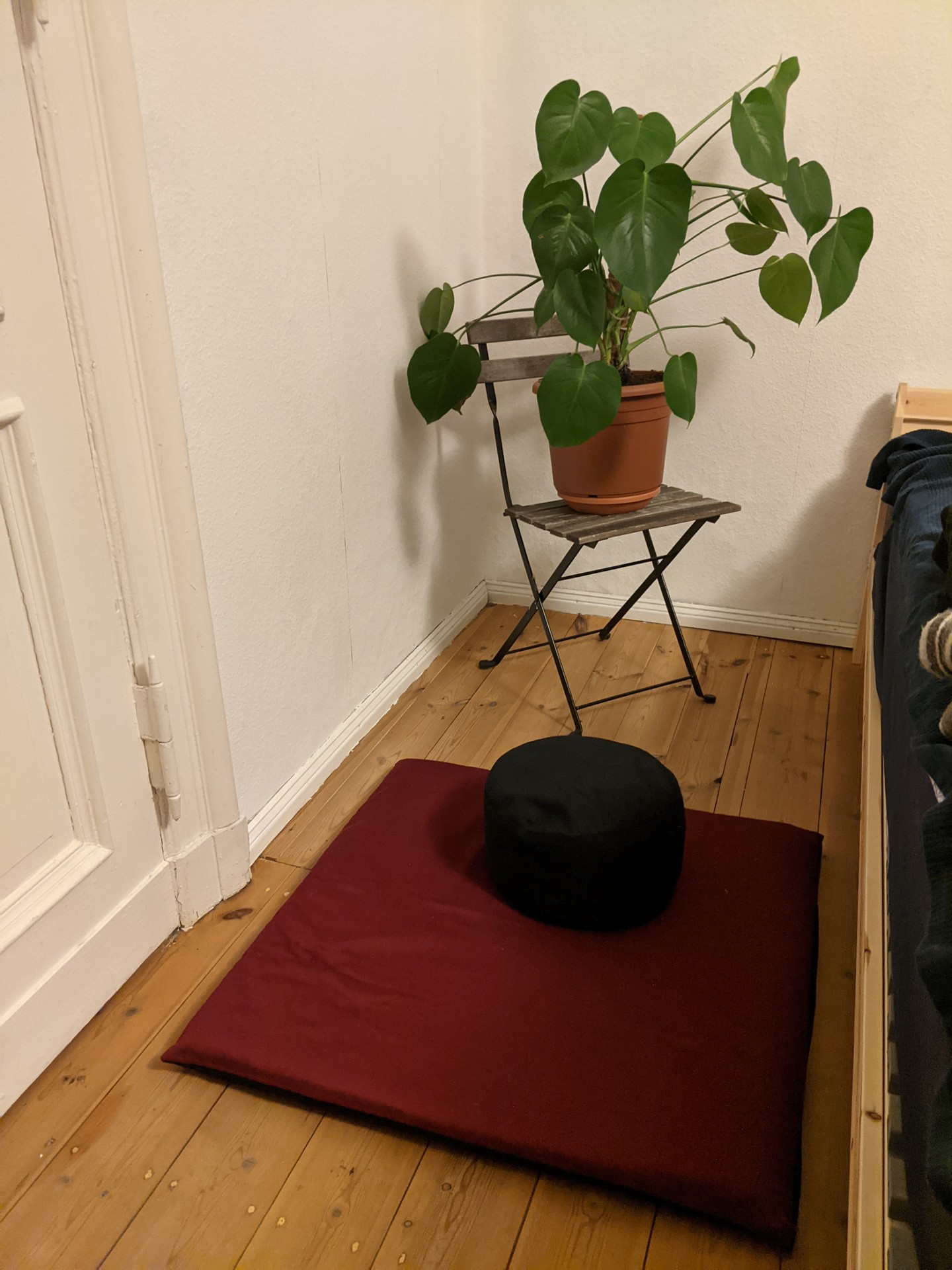
I attended one group sitting (pre-covid) and spent only a week or two meditating with a friend.
I used the Time Recording app for keeping track of the sittings. It is a simple app that allows you to check in your activities, track them in real-time, and export reports to several formats (e.g. CSV). The graphs were made with python using matplotlib and seaborn.
Results
During the first four days of January, I was still attending the retreat. There is a huge discrepancy in the way I meditated during the retreat and the rest of the year. Although these four days count to 2020, I excluded them from some of the graphs. I specifically state which results include these days.
2020 overview
From January 1 until December 31, I meditated 360 hours and 48 minutes, that is 15 days and 48 minutes. This breaks down into an average of 59 minutes and 19 seconds of meditation per day in 2020. In addition, out of 366 days in the last calendar year, I meditated on 322 (88%). The longest streak I had was 135 consecutive days of meditation.
Below is a Github-like heatmap, which shows a general overview of the year. For this graph, I excluded the four days of the retreat. Heatmaps don’t handle extreme outliers well so the retreat days would have made the graph unreadable (12h/day of meditation during the retreat vs. ~1h/day of meditation on a normal day).

We can spot waves of more intense practice (January-March, May-June, and October-November) alternated with periods of “laziness” (April, June-September, and December).
I started the year being very motivated immediately following the retreat. This lasted roughly until mid-March and the beginning of lockdown. Surprisingly, the lockdown did not help me in improving my routine. I maintained the practice but it was at the absolute minimum that I set myself - a half an hour session per day. The numbers stayed low for a few weeks. Without any known reason, I started to meditate more during May and June. Then suddenly in the summer, I experienced a few weeks of hardly any meditation. On one hand, it could be due to vacation and the difficulty of establishing a strict routine in new environments (more on that later). On the other hand, my mind was distracted and lacking motivation (again). It could have been the effects of three months of sitting at home, simply wanting a break or any other reason. Fortunately, the motivation came back in the autumn and, in September, I was back on the cushion. I peaked again in October and ended the year with a slight relaxation.
The same data but presented as a sum of hours per month would look like this (this time including retreat):
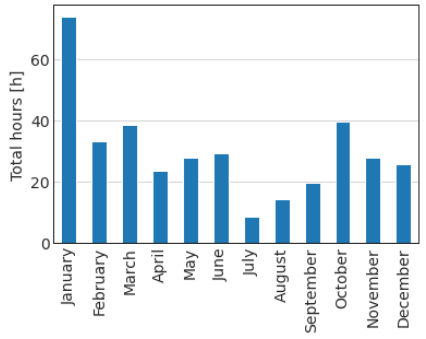
The outstanding result in January is caused by the retreat. During that four days, I meditated for around 37 hours, without which, the graph would have looked much more balanced. The graph highlights the same patterns as seen in the heatmap.
Meditation days
In this section, I looked only at the days of meditation, excluding the retreat days.
I did 445 sittings during 318 days (1.4 sittings/day). Most frequently, I meditated once per day (193 days) and twice per day (123 days). Only twice I scored three sessions during a day.
The sessions took on average 43 minutes with the longest lasting 1 hour and 14 minutes (morning of March 19), and the shortest just 16 minutes (evening of February 10). The histogram and pie chart below show the distribution of the sittings’ duration.


Not surprisingly, most of the sessions took between 30 and 45 minutes (48%). I meditated an equal number of times 45-60 minutes and more than 60 minutes (both 24%). Just a handful of sittings (3%) lasted less than 30 minutes. These were almost entirely sittings done late at night just before going to bed.
A more detailed analysis of the session duration is shown on the violin plot below. Basically, the “fatter” the shape the more sessions of respective duration I had. It’s cool to see how January and October both strongly pull up 1h+, while April and July are fat at the bottom and barely reach the 1h level. It’s pity violin plots don’t show the relationship between the months. The fact that I meditated twice more in November than in July is not exposed.
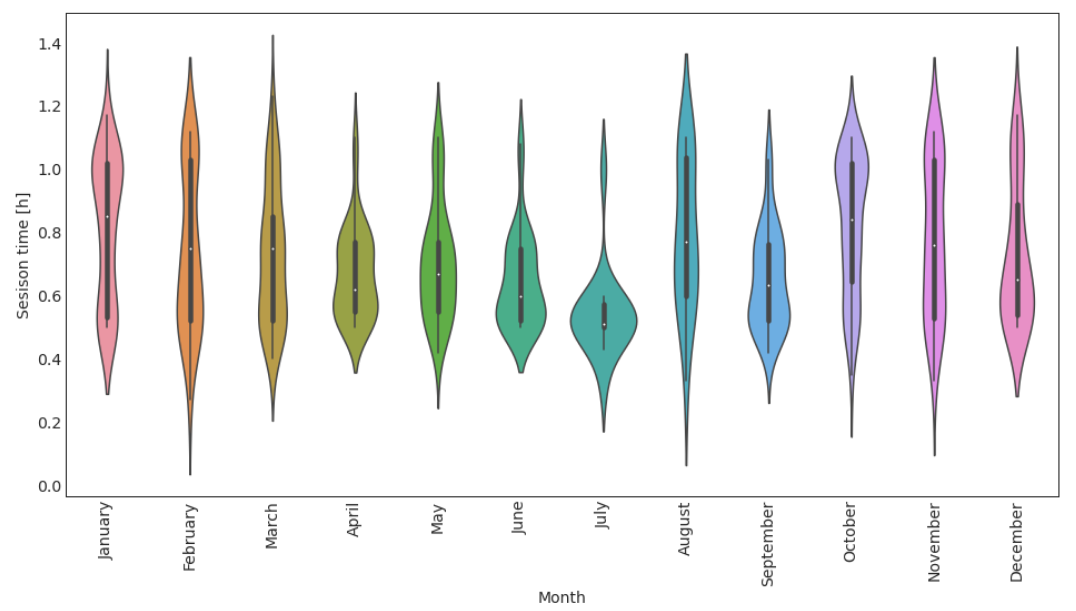
Throughout the year, I had an impression that it was more difficult for me to meditate during the weekends and easier during the week. This observation can be confirmed by looking at the bar graph below. It shows the average meditation time per day of the week.
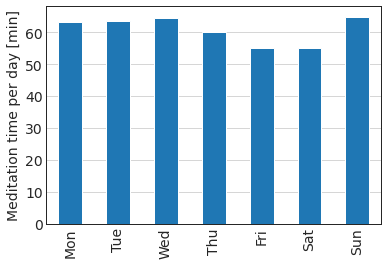
Clearly, the closer to the weekend the less I meditated (not that the weekends in 2020 were that exciting). This was probably caused by a general feeling of laziness and tiredness as the weeks were about to finish. The worst days were Fridays and Saturdays (55 min/day), while the best were Wednesdays and Sundays (65 min/day).
The last analysis in this section looks at my favorite time of day to meditate. I got to practice the most in the mornings (257 sittings started before noon), I barely meditated in the afternoons (12 sittings started between 12 PM and 6 PM), and, quite often, was back on the cushion in the evenings (176 sittings checked in after 6 PM).
The detailed time distribution is shown in the histogram below. The graph kind of surprised me by showing the large difference between morning and evening peak. I have had a strong routine for waking up and immediately meditating which explains the peak at 7:25 AM. I also used to meditate in the evenings but I was more eager to skip it versus in the morning. That would be the peak at 10:33 PM (another small surprise here - I would have bet on an earlier evening peak). In summary, if you messaged me at 7:25 AM or 10:33 PM and I didn’t message back immediately, I was likely meditating.
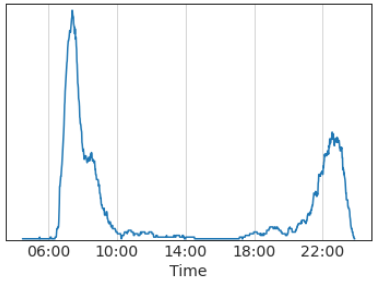
Non-meditation days
Time for the days off.
I did not meditate on 44 days. Most of them (29) were during my small breakdown in July and August. One in February had also an “excuse” - I was super sick during a work trip. The rest: four days in both September and December, one day in October, and five days in November, were purely due to lack of motivation and asking myself if I really wanted to meditate that day (see Section What’s in this for you?).
What was a surprise to me was that most of these days were Saturdays (see the graph below). Also, Sundays stand out negatively. I have already talked about losing my focus on Fridays and Saturdays, but actually, losing so much that I skipped the sittings this many times? Let’s reduce it in 2021!
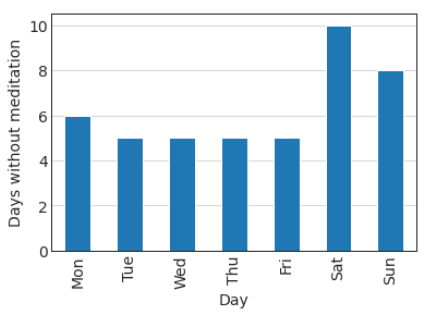
Retrospective and 2021
Throughout 2020, I had these different goals like “I want to reach X hours of meditation” or “on average, I want to meditate Y minutes per day”. Although these kept me motivated daily, the thing that eventually counts is that I made it to maintain the practice. I’m very satisfied that I found ways to do it against so many odds. It feels like, I know how to respond to social pressure and my weaknesses.
Nevertheless, I want to lift my game and there are a couple of things I’ll try this year. First, I continue with the daily practice. Second, I boost Friday and Saturday sessions. Third, I do multiple sessions one after another (two, three one-hour sessions with short breaks in between). Four, I do another 10-day retreat, if the pandemic allows. Five, I do a 2021 report.
Now, off to the cushion!
PS. Thanks, Becky, for improving the readability of the post!